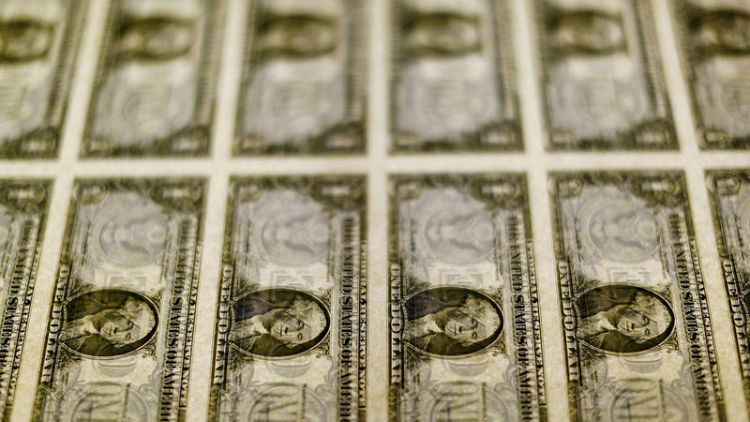By Saikat Chatterjee and Tommy Wilkes
LONDON (Reuters) - The dollar surged to a 29-month high against a basket of rival currencies on Tuesday, while pummelling the euro to its weakest since May 2017.
While the U.S. currency has been in favour for several years thanks to its relatively high interest rate and a strong economy, the ongoing trade war with China and a scramble for funding in U.S. money markets has added fuel to the fire.
The list of reasons for the dollar's strength won't make for easy reading for U.S. President Donald Trump, who has frequently accused other countries of manipulating their currencies and called for a weaker dollar.
Below are a series of charts explaining just why the U.S. currency <.DXY> <EUR=EBS> is so strong.
HOW WELL IS THE DOLLAR DOING?
The dollar's outperformance is particularly broad, with an index compiled by Commerzbank showing that measured against a swathe of rival currencies it has risen more than 3.5% since July 1.
The euro has not declined as much, given it has held up well against a weakening yuan - China is one of the euro zone's biggest trading partners - but the sheer size of the dollar's rally has left the single currency down 0.5% over a similar period.
For a graphic on USD EUR indexes, click https://fingfx.thomsonreuters.com/gfx/mkt/12/6795/6726/USD%20EUR%20indexes.png
The dollar has gained almost regardless of what has happened with U.S.-China trade negotiations, which have emerged as a principal determinant of market sentiment under Trump.
When talks with Beijing have broken down, investors have piled into the dollar looking for a safe haven thanks to its deep liquid markets.
Yet when a truce in the trade war has seemed within reach, traders have also bought the greenback, anticipating an economic boost from any trade deal.
SENTIMENTS DIVERGE
The relative outperformance of the U.S. economy has been a significant driver for dollar strength in the last two years, but it is signs of a deepening downturn in the euro zone that have played a major role recently.
According to Citigroup, the gap between the euro zone and the United States on an economic surprise index has risen sharply. Europe is now underperforming by a bigger margin than at any time since late 2017.
That corresponds with a move lower in the euro from around $1.20 to below $1.09. The euro hit a low of $1.03 in January 2017.
Euro zone manufacturing surveys last week were the most recent to miss expectations - although so have some in the United States - and a Reuters story on Monday on German economic institutes preparing to slash German economic growth forecasts again sent the euro hurtling lower.
For a graphic on CESI and EURUSD, click https://fingfx.thomsonreuters.com/gfx/mkt/12/6791/6722/CESI%20and%20EURUSD.png
MONEY MARKET PRESSURES
Ructions last month in the U.S. "repo" market - a market for short-term funding - may also explain why dollars are so in demand.
Interest rates in the $2.2 trillion market for repurchase agreements rose as high as 10% on Sept. 17 as demand for overnight cash from companies, banks and other borrowers exceeded supply.
For a graphic on U.S. overnight repo and libor-OIS spread, click https://fingfx.thomsonreuters.com/gfx/mkt/12/6792/6723/US%20overnight%20repo%20and%20libor-OIS%20spread.png
Banks and investors called it the most serious disturbance in the U.S. money markets since the 2008-2009 financial crisis.
While the jury is out on the significance of the spike in repo rates, concerns about a shortage of short dated dollar-denominated funding have increased.
Demand for offshore dollars has also grown sharply, according to cross-currency basis swaps, an agreement in which one counterparty borrows one currency from another institution and lends the same value in a different currency.
For a graphic on Money market pressures and DXY, click https://fingfx.thomsonreuters.com/gfx/mkt/12/6793/6724/Money%20%20market%20pressures%20and%20DXY.png
RATE EXPECTATIONS
And then there is the relatively high yield investors earn on U.S. government bonds versus those in the euro zone.
While the Federal Reserve has launched a rate-cutting cycle this year, so has the European Central Bank, and expectations are that U.S. rates will remain far higher than other developed markets for the foreseeable future.
Money markets on balance expect a 25 basis point rate cut to the current Fed rate of 2% in October, but that would still leave rates far above the -0.6% of the euro zone.
Overnight index swaps in the United States all yield more than 1.5% out to a 1-year maturity.
For a graphic on Money market expectations, click https://fingfx.thomsonreuters.com/gfx/editorcharts/US-EUROPE-RATES/0H001QXB68QL/eikon.png
(Additional reporting by Ritvik Carvalho; Editing by Mark Potter)



